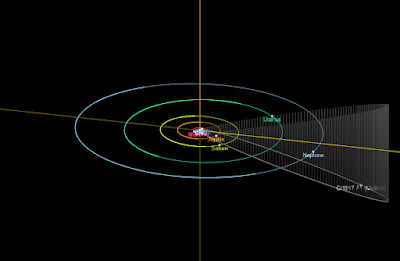The December Monocerotid meteor shower is visible each year between 5 and 20 December, and is expected to peak at about 4.00 am GMT on Thursday 9 December this year, when about two meteors per hour can be expected, although these should be quite bright. The shower takes its name from the constellation of Monoceros, which is faint but lies on the celestial equator, making the shower visible from both hemispheres, although they are likely to be easier to see in the northern hemisphere than the southern. The peak of activity will fall before the first quarter Moon on 11 December 2021, which should prevent observations from being greatly hampered by moonlight.
Meteor
showers are thought to be largely composed of material from the
tails of comets. Comets are composed largely of ice (mostly water and
carbon
dioxide), and when they fall into the inner Solar System the outer
layers of this boil away, forming a visible tail (which always points
away from the Sun, not in the direction the comet is coming from, as our
Earth-bound experience would lead us to expect). Particles of rock and
dust from within the comet are freed by this melting (strictly
sublimation, transforming directly from a solid to a gas due to the low
pressure on it's surface) of the comet into the tail and continue to
orbit in the
same path as the comet, falling behind over time.
The December Monocerotid Meteor Shower has been shown to be caused by the Earth passing through the trail of the comet C/1917 F1 Mellish, where it encounters thousands of tiny dust particles shed from the comet as its icy surface is melted (strictly sublimated) by the heat of the Sun.
C/1917 F1 Mellish was discovered on 20 March 1917 by American amateur astronomer John Mellish. The name C/1917 F1 Mellish implies that it is a comet (C/), and that it was the first such body (1) discovered in the second half of March 1917 (1917 F - the year being split into 24 half-months represented by the letters A-Y, with I being excluded).
C/1917 F1 Mellish completes one orbit every 143 years on an eccentric, orbit tilted at 32.7° to the plane of the Solar System, that takes it from 0.19 AU from the Sun (19% of the average distance at which the Earth orbits the Sun, and inside the orbit of the planet Mercury, which also makes it one of the closest Sun-approaching comets known) to 54.6 AU from the Sun (54.6 times as far from the Sun as the Earth, and considerably outside the orbit of the planet Neptune). As a comet with a period of more than 20 years but less than 200 years, C/1917 F1 Mellish is considered to be both a Periodic Comet, and a Halley-type Comet.
This close approach of C/1917 F1 Mellish to the Sun is particularly conducive for the creation of meteors (lots of material is ablated of the surface of the comet as it passes close to the Sun), but tends to make the orbit of the comet a bit unstable (large amounts of material ablating off the surface of a comet can push it onto a new orbital trajectory). The upshot of this is that C/1917 F1 Mellish appears to be associated with several different minor meteor showers, with the December Monocerotids and November Orionids (or ξ-Orionids) confidently assigned to the comet, and the December Canis Minorids (sometimes the 11 Canis Minorids) and April ρ-Cygnids also thought likely to be caused by material derived from C/1917 F1 Mellish. The Geminid Meteor Shower has also previously been linked to C/1917 F1 Mellish, although this is now usually associated with Asteroid 3200 Phaethon.
See also...



Follow Sciency Thoughts on Facebook.
Follow Sciency Thoughts on Twitter.







